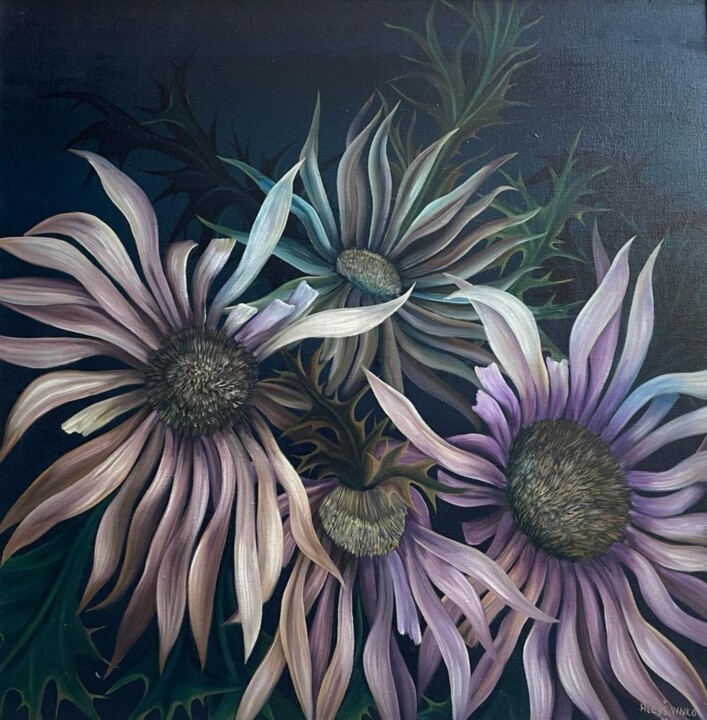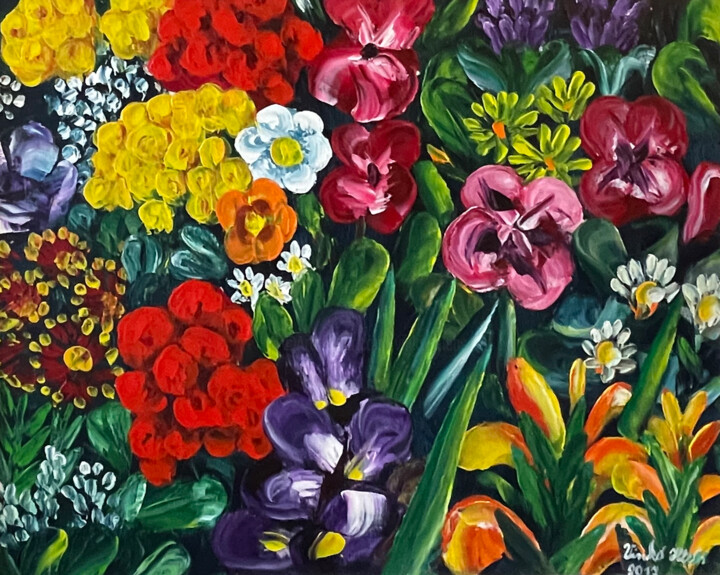Vinko Hlebš's daughter, Marijana Hlebš Radžo, responded to inquiries about him. The painter passed away on July 2nd 2022 as a result of a tragic traffic accident in which his wife, Francka Hlebš, also lost her life. He was highly popular and respected, having held over 90 solo exhibitions and participated in more than 150 group exhibitions. He received numerous awards for his artistic work and had been creating for over 50 years. His daughters Marijana, Urška, and Eva are now taking care of his legacy and future exhibitions. The responses were drawn from knowledge of his father's work, his interviews, a documentary film about him, and art critiques.
What inspired Vinko to create art and become an artist (events, feelings, experiences...)?
He began drawing and painting in his mid-twenties at the encouragement of his older brother, who also bought him his first painting equipment. He held his first solo exhibition at the end of the sixties. His painting career then continued to evolve.
What has been your artistic background, techniques, and subjects you have experimented with so far?
He trained in art courses with renowned Slovenian academic painters Milan Batista and Stane Kregar. His great friend and mentor was also one of the most important Slovenian art theoreticians, Milan Butina. In the beginning of his creative journey, he focused mainly on still life and landscape motifs, derived from nature, thereby indicating what would interest and inspire him as a painter throughout his oeuvre. In the transition from the seventies to the eighties, he decisively chose plant life as his central motif and maintained this thematic focus over the next decades, developing an authentic artistic language through continuous creation. Initially painting strictly realistically, he later transcended his painting by adding a symbolic message to optically captured images from nature. In his later years, a slightly different thematic language emerged, emphasizing the significance of creation and the mystique of life in the cosmos. Thus, he expanded his thematic spectrum from life on Earth to life in the cosmos. His recent paintings introduced a new thematic element - minerals. He also paid a lot of attention to depictions of flowers in vibrant, color-saturated tones, hinting at the presence of color symbolism.
What are the 3 aspects that differentiate him from other artists, making his work unique?
His distinctive feature was mysterious, dark blue-green backgrounds, creating a sense of infinite space and transcendence. Enhanced details of the plant world - meadow or cultivated plants, flowers, fruits, lichens, mosses, various insects - stylized into fantastical forms as if detached from their natural environment and captured in a fleeting moment. They function as images that, with clear and pure forms, transform into enriched scenes beyond reality. The presence of unique symbolism, sometimes obvious, sometimes more subtle. In his works, plants serve as a metaphor for humans, illustrating the human life cycle from birth and growth to decay and passing.
Where did his inspiration come from?
He drew inspiration from his walks in nature. He often joked that nature was his inspiration and his mentor.
What was his artistic approach? What visions, sensations, or feelings does he want to evoke in the viewer?
With a deliberate choice of vivid and intense colors, he aimed not only to please and evoke aesthetic pleasure but also to highlight the richness of metaphorical, symbolic, and expressive dimensions. His artistic credo reflected a personal reflection of the world, characterized by a humanistic and primarily positive orientation, as most of his paintings were optimistically conceived. With a visual sensitivity to the dynamics of life, he raised a series of questions about human existence, touching upon the realities we live in, their obstacles, and consistently offering new possibilities for understanding nature and the world. Therefore, his paintings carry a special spiritual atmosphere, harmonizing colors to encompass the rhythm of the natural and cosmic worlds and reflecting the author's personal artistic expressions with symbolic significance.
He was known for not captioning his masterpieces, preferring viewers to interpret the paintings in their own way and perhaps see other messages that emerged from the painter's subconscious.
What was the process of creating your works? Spontaneous or with a long process of preparation (technique, inspiration from art classics or other)?
Vinko drew inspiration for his creations from nature. He often joked, "Nature is my mentor." He would often lie down in a meadow and observe plants and flowers through a magnifying glass for hours on end, then patiently transfer these anchored images onto canvas. His artworks contained symbolism, so he always had a book on "Symbol Dictionary" by his side in the studio. He would then transfer these symbols onto canvas through his artistic interpretations. Besides brushes and standard painting tools, he also used a magnifying glass for enlarged details from the plant world.
Did you use a particular working technique? If so, can you explain it?
His most common technique was oil on canvas, although there are also watercolors in his collection.
Are there innovative aspects to your work? Can you tell us which ones?
His wealth of colors, shapes, and worlds demonstrated strong artistic will and creative energy, symbolizing the eternal cycle: birth, life, death: suffering and joy. Suffering is necessary for new life to blossom. With his visual symbolism, he connected heaven and earth, this world and the afterlife. Each painting is an image of life, an image of faith and hope in goodness.
Did you have a format or medium with which you are most comfortable? If yes, why?
He is most recognizable for his larger-format paintings of 100 x 100 cm, as it is precisely on these larger canvases that his enlarged details and colors come to the fore.
Where did you produce your works? At home, in a shared workshop, or in his personal workshop? And in this space, how did he organize his creative work?
Vinko created in his studio, which was also his favorite place and where his exceptional creative energy is still felt today. The studio was always very tidy because he was a very organized person. He enjoyed drawing in the early morning hours. Not a day went by without him at least checking in on the studio. He always took drawing supplies with him on trips so he could create on the go. When visitors came, he always showed them some of his artworks and his workspace. He always received great enthusiasm with his paintings. He also shared his knowledge as an educator. Many students, both young and old, received education from him.
Did his work lead him to travel to meet new collectors, to fairs, or exhibitions? If yes, what does it bring you?
Vinko's exhibitions were not limited to Slovenia; he exhibited in Klagenfurt, Vienna (Austria), Zagreb, Ludbreg (Croatia), Geneva (Switzerland), Cologne (Germany), Belgrade (Serbia), and many other European cities. About 600 of his paintings have found their place worldwide. His works can be found in Argentina, Austria, Italy, Germany, France, Poland, as well as throughout Slovenia and the former Yugoslavia. He loved traveling in Italy and admiring the works of Renaissance masters.
How did you envision the evolution of your work and career as an artist in the future?
Unfortunately, the painter is no longer with us, but we, his three daughters, are the ones taking care of his legacy. So far, we have already had two memorial exhibitions in Slovenia, which were extremely well attended, in the capital city of Ljubljana and in his hometown of Tržič. Another exhibition is planned for this year. We are also strengthening his presence on social media and showcasing his works in the Artmajeur online gallery. There is tremendous interest in his works.
What is the theme, style, or technique of your latest artistic production?
In his recent paintings, a new thematic element has emerged - minerals. From a distant view of the earth, he descended beneath the earth's surface and organized the crystals he found there into compositions resembling flowers. He depicted floral shapes with crystals, thereby imbuing inanimate matter with vitality through organic imagery. The minerals thus form flower petals at the top of stems, resembling beautifully blooming sea grass or corals. He also paid a lot of attention to depictions of flowers in vibrant, color-saturated tones, suggesting the presence of color symbolism.

Can you tell us about Vinko's most important exhibition experience?
Certainly, the most resonant exhibition was the one in Vienna at the Kleine Galerie, Austria, in 1986, which was exceptionally well received both by the audience and by art critics. Both Slovenian and Austrian media reported on the exhibition.
If Vinko could have created a famous work in art history, which one would he have chosen? And why?
He would undoubtedly have chosen the creation of Adam on the ceiling of the Sistine Chapel (Sacellum Sixtinum). He was a great admirer of the Renaissance and masters of oil painting. He loved traveling to Florence, Rome, and the Vatican, where he had the opportunity to admire these masterpieces in person.
If he could have invited a famous artist (living or dead) to dinner, who would it be? How would you suggest he spend the evening?
It's quite difficult to choose just one, so I'll mention two. Certainly, Michelangelo, as he was his great admirer, and from more recent times, it would surely be Salvador Dali. The evening would be filled with laughter, as Vinko was known as a great entertainer, and every visit to his house would shake with laughter. Vinko's wife, who was always by his side, would ensure a great dinner and enjoyment with a good glass of wine. The evening would continue in Vinko's studio, where he always invited guests, engaging in discussions about art. Vinko would showcase his works and ask the masters for their opinions. The gathering would surely extend late into the night, as they would never run out of topics to discuss.






 Olimpia Gaia Martinelli
Olimpia Gaia Martinelli












